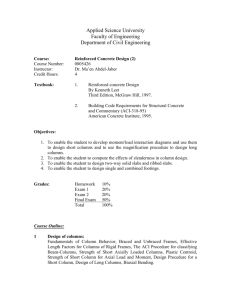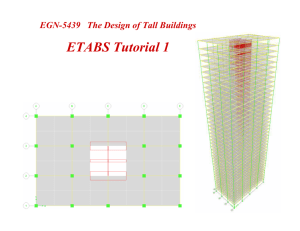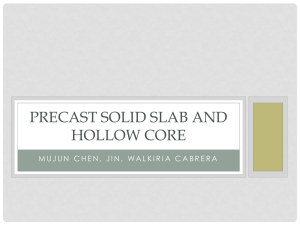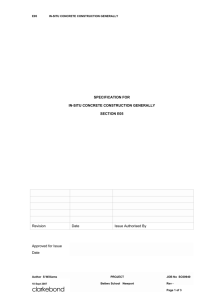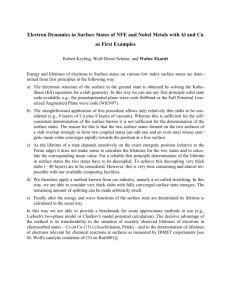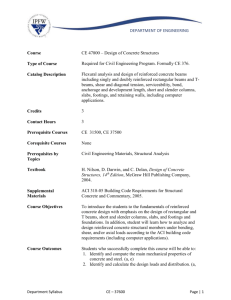Precast Concrete Slabs
advertisement
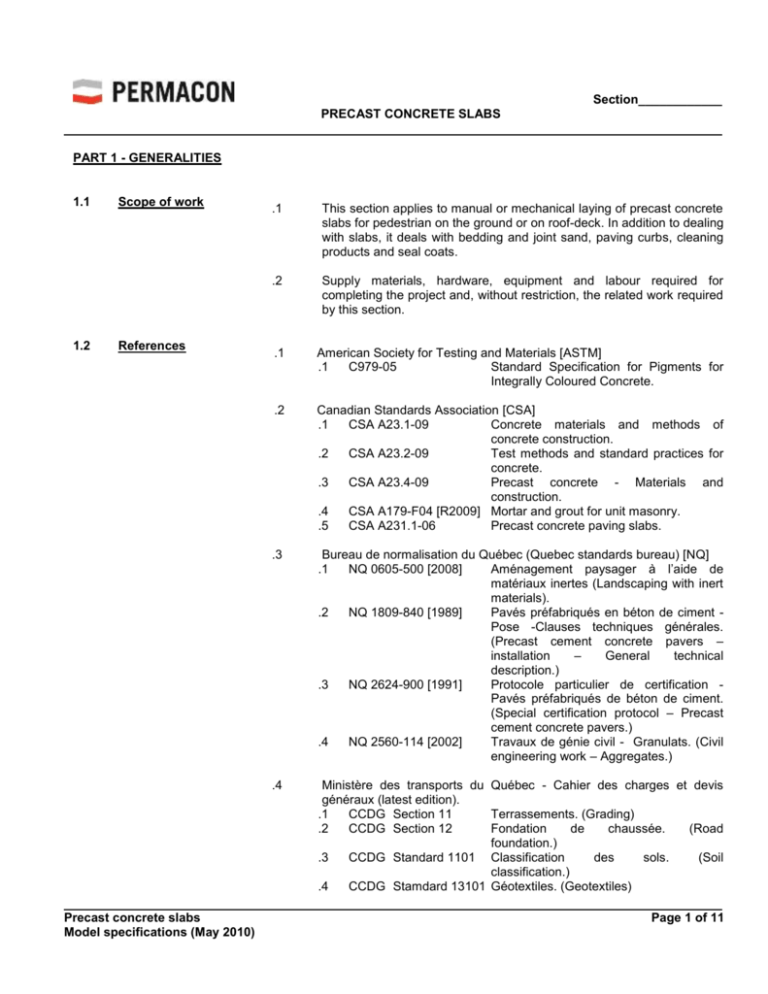
Section____________ PRECAST CONCRETE SLABS PART 1 - GENERALITIES 1.1 1.2 Scope of work References Precast concrete slabs Model specifications (May 2010) .1 This section applies to manual or mechanical laying of precast concrete slabs for pedestrian on the ground or on roof-deck. In addition to dealing with slabs, it deals with bedding and joint sand, paving curbs, cleaning products and seal coats. .2 Supply materials, hardware, equipment and labour required for completing the project and, without restriction, the related work required by this section. .1 American Society for Testing and Materials [ASTM] .1 C979-05 Standard Specification for Pigments for Integrally Coloured Concrete. .2 Canadian Standards Association [CSA] .1 CSA A23.1-09 Concrete materials and methods of concrete construction. .2 CSA A23.2-09 Test methods and standard practices for concrete. .3 CSA A23.4-09 Precast concrete - Materials and construction. .4 CSA A179-F04 [R2009] Mortar and grout for unit masonry. .5 CSA A231.1-06 Precast concrete paving slabs. .3 Bureau de normalisation du Québec (Quebec standards bureau) [NQ] .1 NQ 0605-500 [2008] Aménagement paysager à l’aide de matériaux inertes (Landscaping with inert materials). .2 NQ 1809-840 [1989] Pavés préfabriqués en béton de ciment Pose -Clauses techniques générales. (Precast cement concrete pavers – installation – General technical description.) .3 NQ 2624-900 [1991] Protocole particulier de certification Pavés préfabriqués de béton de ciment. (Special certification protocol – Precast cement concrete pavers.) .4 NQ 2560-114 [2002] Travaux de génie civil - Granulats. (Civil engineering work – Aggregates.) .4 Ministère des transports du Québec - Cahier des charges et devis généraux (latest edition). .1 CCDG Section 11 Terrassements. (Grading) .2 CCDG Section 12 Fondation de chaussée. (Road foundation.) .3 CCDG Standard 1101 Classification des sols. (Soil classification.) .4 CCDG Stamdard 13101 Géotextiles. (Geotextiles) Page 1 of 11 Section____________ PRECAST CONCRETE SLABS 1.3 Shop drawings 1.4 Technical specifications 1.5 1.6 1.7 Samples Project mock-up Measurements invoicing purposes Precast concrete slabs Model specifications (May 2010) for .1 Shop drawings must indicate or show the layout, model and relationship between slab joints and fixed installations, as well as details specific to work performed. [Note to specification writer: Request shop drawings only if features, conditions or particular models require them.] .1 Submit the technical specification sheets for the following concrete slabs: .1 Test results showing compliance with CSA Standard A231.2-09; .2 Test certificate showing compliance with CSA Standard A23.2-09; .3 Manufacturer’s specifications and installation instructions. .2 Submit specifications with respect to sampling, testing, sourcing, grain size distribution, mineralogical nature and characteristics of the following materials: .1 Aggregate for granular subbase; .1 Bedding sand; .2 Joint sand; .3 Stabilized joint sand. .3 Submit specifications for geotextile membranes indicating mechanical and physical features for each type used. .1 Submit a full-size sample of each type of slab used. .2 Submit a 1 m x 1 m sample of each type of geotextile used. .1 Lay out a 3 m x 3 m model of the project prior to installing the units on the area to be covered. This mock-up will be used to determine the live load imposed by the bedding, joint width, lines, layout, colours and the distribution of colours and textures. .2 This mock-up, once it has been accepted by the Consultant, will constitute the standard for determining job compliance and may be incorporated into the project. .3 Protect this sample with a view to its integration into the finished work. .1 Fixed price contract: all work will be paid for according to the lump sum indicated on the bid form. .2 Unit price contract: all work will be paid for according to the unit price indicated on the bid form. [Note to specification writer: Keep paragraph that applies to project.] Page 2 of 11 Section____________ PRECAST CONCRETE SLABS PART 2 - PRODUCTS 2.1 2.2 2.3 Excavation, backfill and grading .1 Materials to comply with CCDG section 11 specifications. Geotextiles Granular subbase MG-56 .1 Geotextiles to comply with CCDG 13101 standard. [Note to specification writer: The precise choice of geotextile should be determined with the assistance of a civil engineer.] .1 Grain size distribution for MG-56 subbase materials to comply with NQ standard 2560-114 [2002]. Screen designation 31.5 mm 20 mm 14 mm 5 mm 1.25 mm 0.315 mm 0.080 mm % of passing through 100 90 to 100 68 to 93 35 to 60 19 to 38 9 to17 2 to 7 Tableau 2.3a [Note to specification writer: The thickness and composition of the granular subbase should be determined with the assistance of a civil engineer.] .2 Precast concrete slabs Model specifications (May 2010) Materials for granular subbase: .1 Aggregate to comply with NQ standard 2560-114 [2002]. Page 3 of 11 Section____________ PRECAST CONCRETE SLABS 2.4 Bedding sand .1 Grain size distribution for bedding sand materials in accordance with the CSA standard A23.1-09: Screen designation 10 mm 5 mm 2.5 mm 1.25 mm 0.630 mm 0.315 mm 0.160 mm 0.080 mm % of passing through 100 95 to 100 80 to 100 50 to 90 25 to 65 10 to 35 2 to 10 0 to 3 Table 2.4a .2 2.5 Sand and stabilized sand for joint filling .1 [Note to specification writer: Choose the bedding material type according to the anticipated use of the concrete slab surfaces.] Bedding materials: .1 Aggregate in accordance with CSA A23.1-09 standard. The sand for filing joints is made up of natural sand, manufactured sand, or a mixture of the two to comply with CSA A179-F04 [R2009] standard: Screen designation 5 mm 2.5 mm 1.25 mm 0.630 mm 0.315 mm 0.160 mm 0.080 mm % of passing through 100 90 to 100 85 to 100 65 to 95 15 to 80 0 to 35 0 to 1 Table 2.5a [Note to specification writer: Choose the type of materials for joint filling depending on use of concrete slab surfaces.] .2 Precast concrete slabs Model specifications (May 2010) Materials for filling joints: .1 Aggregate to comply with CSA A179-F04 standard. Page 4 of 11 Section____________ PRECAST CONCRETE SLABS 2.6 Precast concrete slabs .1 Precast concrete slabs: compliant with the requirements of CSA A231.1-06 and NQ 2624-900 [1991] standards and the following requirements. .2 Precast concrete slabs for use on the ground: .3 .1 Portage slab: Dimensions 391 mm x 534 mm x 43 mm Colour Range beige and black Range grey and charcoal Range sandy beige Finish Similar to natural stone .2 Mondrian slab Module A 190 mm x 380 mm x 50 mm Module B 380 mm x 380 mm x 50 mm Module C 570 mm x 380 mm x 50 mm Range colours Richmond grey, Danville beige, Hudson Brown, Baltik grey, Monterey beige, Radisson grey Finish Irregular edges and chiselled finish .3 Mega Hemmingford precast concrete slab Module #3 406 mm x 635 mm x 38 mm Module #5 508 mm x 813 mm x 38 mm Colour Batiscan grey Thera beige Finish Similar to flagstone .4 Hemmingford precast concrete slabs Dimensions 394 mm x 406 mm x 38 mm Colour Batiscan grey Thera beige Finish Similar to flagstone Precast concrete slab for use on roof-deck: .1 Versailles slab: Dimensions 610 mm x 610 mm x 50 mm Colour Limestone grey,Trenton grey Luxor beige, Indiana beige Finish Shotblasted (RocArt) [Note to specification writer: Verify the concrete slab delivery dates in order to ensure the availability of the products required for completing the work.] [Note to specification writer: The thickness of the slabs used will have to be determined with the assistance of a competent civil engineer in compliance with the local steps to be followed with regard to calculating Precast concrete slabs Model specifications (May 2010) Page 5 of 11 Section____________ PRECAST CONCRETE SLABS coverings or with the Tech Spec technical bulletins, construction details and the study software developed by ICPI. The guidelines with relation to calculations and the requirements involving the industrial and port applications must be prepared from manuals entitled: Port and Industrial Pavement Design with Concrete Pavers and Airfield Pavement Design with Concrete Pavers [Canadian Edition] from ICPI relating to airport applications.] 2.7 2.9 2.10 Paving curbs .1 Permacon precast concrete curbs. .2 Permapro type PVC curbs by Permacon .3 Concrete curbs poured on site. According to requirements of specifications section [ ]. .1 Cleaning product: Permapro rust cleaner; Permapro efflorescence cleaner; Permapro oil and grease cleaner. [Note to specification writer: Choose the cleaning product according to the recommendations of the cleaning product manufacturer and the slab manufacturer. The use of inappropriate cleaning products can void the warranty provided by the manufacturer.] .1 Permapro seal coat: [Note to specification writer: Seal coats may be needed to improve appearance and facilitate surface flow of precipitation and contaminating materials or to prevent the removal of joint-filling material when joints are subjected to extreme conditions as, for example, jet blasts or propeller slipstreams. Choose the seal coat according to the manufacturer’s recommendations. The use of inappropriate seal coats can void the warranty provided by the manufacturer of the precast concrete slabs.] Cleaning product Seal coat Precast concrete slabs Model specifications (May 2010) Page 6 of 11 Section____________ PRECAST CONCRETE SLABS PART 3 - COMPLETION 3.1 3.2 3.2.1 3.2.2 3.2.3 3.2.4 Project compliance Concrete slabs on granular base Inspection .1 Unless otherwise specified, lay the slabs in accordance with NQ standard 1809-840 [1989] specifications. .1 Section 3.2 deals with the installation of precast concrete slabs on compacted granular bases on the ground. .1 Notify the consultant at the end of each of the following steps: .1 completion of grading. .2 installation of geotextile membranes. .3 completion of granular subbase. .4 completion of sand bedding. .5 installation of the slabs. .2 Have the work approved at the end of each step. Excavation, backfill and grading .1 Complete work in accordance with CCDG section 11 specifications. Geotextiles .1 Spread the geotextile membranes on the ground without folds and tuck up the edges to protect the sides of the foundation. Vehicle circulation on geotextile membranes is forbidden. .1 Complete the work in accordance with CCDG section 12 specifications. .2 Ensure that the granular subbase is levelled and compacted in compliance with specifications for the surface receiving the slabs. In the event of non-compliance, notify the Consultant and only restart work after receiving new instructions from Consultant. .3 Unless otherwise specified, the granular subbase should exceed the surface to be paved by at least one and a half times its own thickness. .4 Ensure that the surface of the granular subbase does not vary by ±5 mm in relation to the indicated level (measured with a 3-m ruler), to allow for the installation of the bedding sand in a consistent thickness. In areas where this tolerance limit has been exceeded, correct its profile by adding or removing granular fill. .5 The surface of the granular subbase must be sufficiently sealed to prevent percolation of the bedding material, which would cause future damage for surface materials. Granular subbase Precast concrete slabs Model specifications (May 2010) Page 7 of 11 Section____________ PRECAST CONCRETE SLABS 3.2.5 3.2.6 3.2.7 .6 Ensure that the granular subbase is not frozen and that there is no accumulation of stagnant water when the bedding material is installed. .7 Have the Consultant approve the final installation of the granular subbase before proceeding with the installation of the sand bedding. [Note to specification writer: The thickness of the granular subase will have to be determined with the assistance of a competent civil engineer and must take into consideration the nature of the local soils and the loads to be carried.] .1 Lay curbs in accordance with manufacturer’s recommendations. .2 Ensure that the level and alignment of curbs comply with the specifications for laying slabs. In the event of non-compliance, notify the Consultant and only restart work after receiving new instructions from the Consultant. .1 Do not compensate for defects in the evenness or level of the granular subbase by increasing or decreasing the thickness of the bedding sand. .2 Spread the bedding material on the granular subbase with levelling rulers in order to obtain a 25-mm layer before compaction. .3 Do not use joint filling sand as bedding material. .4 Keep bedding material loose until slabs are installed, and do not compact the bedding material. Break up, loosen and restore areas of the bedding material that have been compacted by whatever means, and prohibit any traffic on the bedding material after it has been laid. .5 Ensure that the bedding material is not frozen and that no stagnant water has accumulated when the slabs are installed. .1 Install slabs according to specified patterns and models. Lay slabs manually or mechanically, allowing for slopes, levels, sizes, layouts and patterns as illustrated on the plans. .2 Unless otherwise specified, nominal 3- to 5-mm gaps must be left between slabs or between slabs and curbs. .3 The alignment of horizontal joints must not vary by more than 15 mm over a total length of 15 metres. .4 Only use complete units or appropriate end, angle or edge units along edges. .5 Cut slabs with a masonry saw. Unless specified otherwise in contract Laying curbs Installation of bedding material Installation of slabs Precast concrete slabs Model specifications (May 2010) Page 8 of 11 Section____________ PRECAST CONCRETE SLABS documents, only use complete units along the entire paved perimeter: on the edges and sides, and in the corners. 3.3 Concrete slabs on roofdeck Precast concrete slabs Model specifications (May 2010) .6 All concrete slabs used for automobile traffic must not be cut by more than one third of their total size. .7 Avoid all machine, vehicle and equipment traffic on concrete slab surfaces before they have been vibrated and their joints filled. Position pallets of slabs and other materials to avoid exceeding the bearing capacity of the covered surface and to avoid damaging it in any other manner. .8 Inspect the installed slabs and replace those that are chipped, broken or damaged in any other manner according to the Consultant’s instructions. .9 Tamp down the surface of the concrete slabs with a low-range, highspeed vibrating plate compactor with centrifugal compacting force of at least 18 kN at a frequency of 75 to 100 Hz in order to settle slabs into the bedding sand. Move the vibrating plate over the slabs at least three times in different directions. .10 Spread, fill and simultaneously vibrate the sand into the joints. Continue to spread the joint sand and tamp the slabs with a vibrating plate compactor until the joints are completely filled. The vibrating plate compactor must not be used less than 1 m from the unsecured edges of a block pavement. .11 Complete the installation up to 1 m from the edge of the surface to be covered by filling the joints with sand at the end of each work period. .12 Once the installation of the slabs has been completed sweep up the surplus joint sand. .13 Continue filling the joints during the following days under worksite traffic to ensure additional compaction of the sand in the joints. .14 The final level of the paved surface should not vary by more than 5 mm (plus or minus) as measured with a 3 m ruler. .15 The paved slab surface should be 3 to 4 mm above catch basins, drainage channels and adjacent concrete aprons. .16 Ensure that the level of the slab covering meets specifications. .1 Section 3.3 deals with the installation of precast concrete slabs on roofs with prefabricated supports. [Note to specification writer: Ensure that the roof is capable of supporting the load of the proposed plan. The safe bearing capacity of the roof will have to be determined with the assistance of a competent Page 9 of 11 Section____________ PRECAST CONCRETE SLABS structural engineer. Make sure the roof is able to support the type of development proposed. The compatibility of the proposed developments on the roofs will have to be determined with the assistance of a competent building architect.] 3.3.1 3.3.2 3.3.3 3.3.4 3.3.5 Inspection .1 Notify the consultant at the end of each of the following steps: .1 preparation of the roof. .2 installation of protective boards and geotextile membranes. .3 installation of prefabricated supports (pedestals). .4 installation of slabs. .2 Have the work approved at the end of each step. .1 .2 Ensure that all surfaces, membranes, insulating material, protective board and drainage system are free from dust, oil, grease and all debris. Verify that the roof surface is clean and dry. .1 Spread the geotextile without folds on the roof platform. .2 Ensure that the roof drains are covered by the geotextile in order to preserve the integrity of the drainage system. .1 Install the prefabricated supports in compliance with the manufacturer’s recommendations. [Note to specification writer: Ensure that the prefabricated supports chosen are compatible with the type of roof. Ensure that the supports are compatible with the concrete slabs and the loads that have to be supported.] .1 Install slabs according to the specified patterns and models. Place the slabs manually or mechanically, taking into account slopes, levels, sizes, layouts and patterns as illustrated on the plans. .2 Unless otherwise specified, nominal 3 to 5 mm gaps must be left between slabs or between slabs and borders. .3 The alignment of horizontal joints must not vary by more than 15 mm over a total length of 15 metres. .4 Only use complete units or appropriate end, angle or edge units along edges. .5 Cut slabs with a masonry saw. Unless specified otherwise in contract documents, only use complete units along the entire paved perimeter: on the edges and sides, and in the corners. .6 Lay the slabs on the prefabricated supports while ensuring that the supports themselves are supported in an adequate manner. Roof Geotextiles Installation of prefabricated supports Installation of the slabs Precast concrete slabs Model specifications (May 2010) Page 10 of 11 Section____________ PRECAST CONCRETE SLABS 3.4 .7 Inspect the installed slabs and replace those that are chipped, broken or damaged in any other manner according to the Consultant’s instructions. .8 Ensure that the level of the slab covering meets specifications. .1 Remove any non-adhering foreign matter from slab surfaces. .2 Apply cleaning recommendations. Cleaning .3 3.5 Application of seal coating Precast concrete slabs Model specifications (May 2010) products as stipulated in manufacturer’s Keep the finished surface free from all stains. .1 Ensure that the surface of the slabs to be coated is dry, clean, properly prepared and free of any efflorescence or foreign matter. .2 Apply seal coating as stipulated in manufacturer’s recommendations. .3 Prevent all traffic on surfaces covered by the seal coating until it has had time to dry and harden properly. Page 11 of 11


